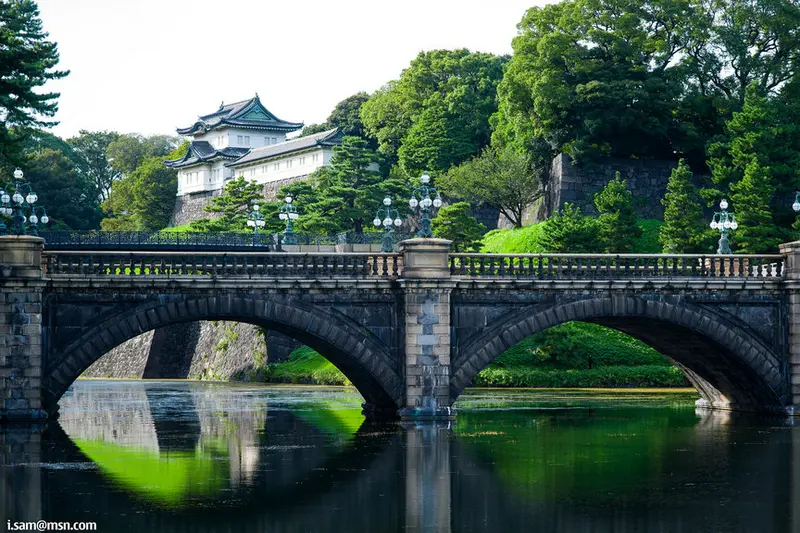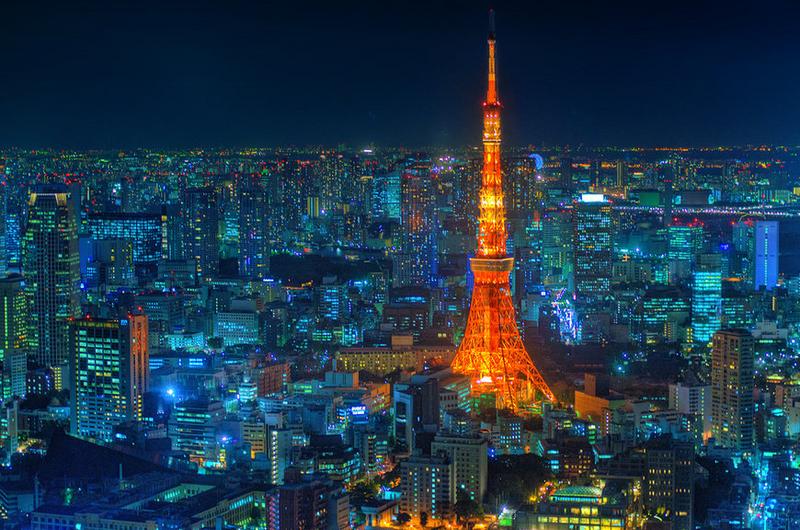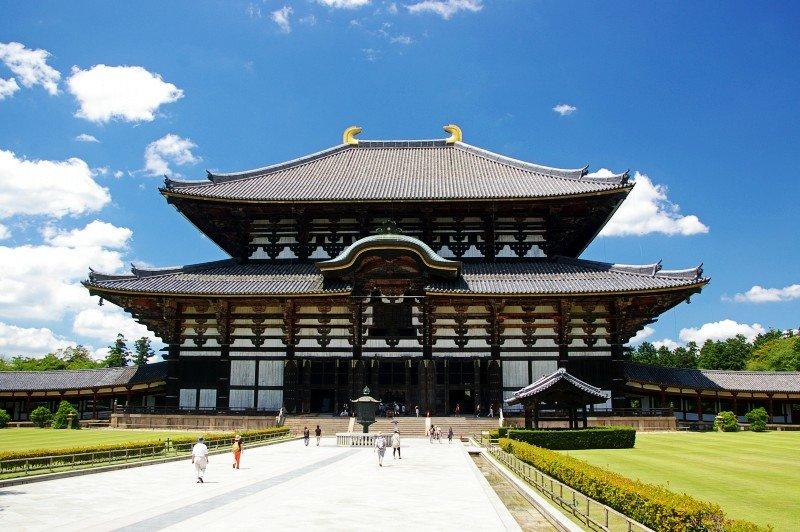Five Days in Japan: Tokyo Kyoto Nara Free Tour
4 cities |
16 attraction(s) |
total distance 483
km
 TIPS
TIPS
Day1
Day2
Day3
Day4
Day5
Day1: Tokyo
3 attraction(s) ·
4 km
1
The Imperial Palace is a representative landmark in the center of Tokyo, consisting of the Imperial Palace Plaza, Niju Bridge, Imperial Palace Outer Garden, and Imperial Palace East Garden. During the Meiji Restoration, the Emperor moved from Kyoto to this location, giving it the name "Imperial Palace". Now, a portion of the area is open to the public as a park, with entrances at Hibiya Station to the south and Otemachi Station to the north.
Despite the surrounding skyscrapers, the Imperial Palace still retains the atmosphere of the Edo period, giving a strong sense of history. As a symbolic building of Tokyo, it has witnessed the changes of time and protected the descendants of Edo.
Around the Imperial Palace, taking a stroll along the moats, you can see the walls of the Edo Castle, as well as sculptures of the samurai Kumasu Narimasa, beautiful carved decorations on the entrance gate of Otemon, and the entrance to the Kitamru Park at the Tateyammon. In the East Garden, there is the Nino-Maru, where you can see the grand shogunate villa and exquisite gardens, which are precious legacies from the Edo period.
2
km
3
Tokyo Tower, also known as Nihon Denpa-tō, is located in Shiba Park, Minato Ward, Tokyo, Japan. It is a red and white tower modeled after the Eiffel Tower in Paris, standing at a height of 332.6 meters, 8.6 meters taller than the Eiffel Tower. Built in October 1958, it was once the tallest structure in Tokyo until the completion of Tokyo Skytree (634 meters) in February 2012, and has always been one of the landmarks of Tokyo. The tower has an observation deck at the top, offering panoramic views of the entire Tokyo metropolitan area, with a clear view of Mount Fuji on a clear day. The tower's lighting changes colors according to the season, with special decorations for holidays such as Christmas.
Day2: Tokyo
3 attraction(s) ·
11 km
1
Ueno Park is one of Tokyo's famous parks, covering a large area and hosting multiple facilities such as a zoo, art museum, and museums. It also has a rich natural landscape, including famous landmarks such as Shinobazu Pond and Takegata Fountain. The park's most famous symbol is the bronze statue of Takamori Saigo. In spring, Ueno Park is a popular spot for cherry blossom viewing in Tokyo, where visitors can admire the beautiful cherry blossoms in full bloom.
3
km
2
Sensoji Temple is the oldest temple in Tokyo, built in 628. According to legend, a fisherman discovered a golden statue of the goddess Kannon and built a tower to enshrine it in the same spot. Later, it was expanded into its current size. During the Edo period, Tokugawa Ieyasu ordered the rebuilding of Sensoji Temple, which gradually became a cultural center.
Climbing the gate with a giant lantern, the Kaminarimon gate, is one of the symbols of Asakusa and even Japan. In the middle of the gate are statues of the gods of thunder and wind, and its formal name is "Furaijin Gate."
Through the shopping street, you can see the main hall, which gradually became prosperous because Ieyasu designated it as a place of prayer for the shogunate. In the northeastern corner of Sensoji Temple, there is also Asakusa Shrine, which was built in the Heian period and has an elegant and beautiful architectural style.
Every May, Sensoji Temple holds the Sanja Festival, one of the three major festivals in Edo, which is the grandest event in Asakusa. This festival originated in the Edo period and fully displays the traditional culture and human emotions of the time. In the activity of carrying the shrine, several dozen people dress up in the style of the old-fashioned and gather from various directions to Sensoji Temple, creating a lively atmosphere.
9
km
3
Started as a kimono store in 1886, this famous destination is now known for high fashion shopping.
Day3: Kyoto
3 attraction(s) ·
7 km
1
Kinkaku-ji, also known as the Golden Pavilion, was originally built as a retirement villa for the shogun Ashikaga Yoshimitsu in 1397. It later became a Zen temple. The name "Golden Pavilion" comes from the gold leaf that covers its exterior. In 1950, the temple was unfortunately set on fire and the golden building was burned down, but it has since been rebuilt to its former glory. Kinkaku-ji is a three-story building with the first floor called Hojo, the second floor housing a shrine dedicated to Kannon, and the third floor as a square-shaped Buddhist hall with three statues of Buddha. The temple's golden reflection shimmering in the surrounding Mirror Pond is a beautiful sight and one of the iconic landmarks of Kyoto.
Unlike other attractions, visitors of Kinkaku-ji do not enter with a ticket, but instead receive a stamp with a blessing. Within the temple grounds, visitors can use Chinese and Korean fortune slips for divination and purchase the famous matcha ice cream.
6
km
2
Gion Corner is a theater that showcases traditional Kyoto performing arts. The performances usually last around an hour and include Kyoto-style dance, tea ceremony, flower arrangement, koto music, Noh theater, and Bunraku puppetry. Visitors can experience the rich cultural heritage of Kyoto through these performances. Additionally, the Kabuki Gallery displays stage videos and Kabuki-related items such as hairpins.
1
km
3
Hanamichi, located in the Higashiyama district of Kyoto, is a north-south street. The most famous section is the old-fashioned street from Kennin-ji Temple. There is also the famous Kaburenjo Theater, where grandiose dance performances by Kabuki actors and Geishas are held in spring and autumn.
The buildings along the street are full of Kyoto's distinctive features. This year, Leica and Hermès have opened alternative experiential stores here. By crossing four intersections from Hanamichi towards the north, you can reach the elegant southern end of Shirakawa.
Visiting Q-Home upstairs for a Hanamichi kimono experience and transformation, and then taking photos on Hanamichi street is an excellent local experience. On weekends, Japanese girls may also invite their friends to dress up in kimonos and take photos here. If you're lucky, in the evening, you might even encounter hurried Kabuki actors and Geishas going to tea houses for work.
It is important to note that Hanamichi street can get crowded with people and vehicles are allowed to pass through. Therefore, when taking photos, it is necessary to be mindful of vehicles and ensure your own safety.
Day4: Kyoto
3 attraction(s) ·
11 km
1
Arashiyama is a famous scenic spot in Kyoto, known for its cherry blossoms and maple trees along the Katsura River. The iconic Bamboo Grove is also a popular attraction for visitors. Whether it's admiring cherry blossoms, autumn foliage, or strolling through the bamboo forest, Arashiyama exudes the unique beauty of Kyoto. The area is also home to many temples and shrines, often featured in historical tales and classical literature. Don't miss the hot springs in Arashiyama, where you can fully enjoy the pleasure of bathing in onsen.
1
km
2
Togetsukyo Bridge in Kyoto City spans across the Katsura River, providing convenience for pedestrians and vehicles. The northern side of the bridge belongs to the Sagano area in the Ukyo Ward, while the southern side is in the Arashiyama area of the Nishikyo Ward. If you cross the bridge from the northern side and pass through Sagano-Nakajimacho, you can reach the foot of Mt. Arashiyama. The surrounding area of Arashiyama is a famous spot in the western suburbs of Kyoto for cherry blossoms and autumn leaves viewing, often experiencing severe traffic congestion during the peak tourist season.
10
km
3
Kiyomizu-dera is a historical temple located on Mount Otowa in the eastern part of Kyoto. It was first built in 778 and has been rebuilt several times, with the current structures mostly dating back to the period between 1631 and 1633. The temple's main hall, Niomon Gate, Western Gate, Three-story Pagoda, and Bell Tower have been designated as national treasures and important cultural properties. The most famous feature of the temple is the Kiyomizu stage, a platform that was built without using a single nail and is located on a cliff, offering a panoramic view of the city of Kyoto. The temple also features the Otowa Waterfall, where three separate streams represent longevity, academic success, and finding love. In addition to the main temple, there are other buildings located throughout the grounds, such as the Three-story Pagoda and Zuigu-do Hall. Visitors can purchase tickets to participate in the "Womb World Walk," a prayer experience that symbolizes being inside the womb of a Bodhisattva. The upcoming "Kanji of the Year" event will take place at Kiyomizu-dera, and the Kyoto Kanji Association considers it a typical representative of Japanese temples. Kiyomizu-dera is designated as a UNESCO World Heritage Site and is considered one of the iconic landmarks of Kyoto due to its lush scenery and long history.
Day5: Nara > Osaka
4 attraction(s) ·
32 km
1
Encounter a fairy tale of deer and cherry blossoms, Nara Park is famous for its approximately 1,200 free-roaming deer. On the vast land area of 660 hectares, various cherry blossom trees, mainly including Yae-zakura, are planted.
1
km
2
Todai-ji Temple is a famous temple of the Hua-yen Sect in Japan, also known as Da Hua-yen Temple, the Four Heavenly Kings Hall of the Golden Light Guard Temple, and so on. It is located in the eastern part of Heijo-kyo (now Nara), and is one of the seven great temples of the southern capital, with a long history of about 1200 years. In 1998, Todai-ji Temple was listed as a World Cultural Heritage Site as a part of the historical relics of ancient Nara. The Great Buddha Hall of Todai-ji is one of the largest wooden buildings in the world, with a frontage of 57 meters and a depth of 50 meters. Within the Great Buddha Hall stands the 15-meter-high Rushana Buddha. In addition, there are other famous buildings in the Todai-ji Temple complex such as the South Gate, the February Hall, the March Hall, and the Shoso-in Repository, all having extremely high historical, cultural, and artistic value.
32
km
3
どうとんぼり
Dotonbori is Osaka's most bustling district and also the local food center. It is the birthplace of Osaka's food culture and attracts many travelers who come to taste the cuisine. From takoyaki, teppanyaki, yakiniku, kushikatsu, revolving sushi to fugu cuisine, it covers almost all of Osaka's characteristic cuisine, even inconspicuous small shops can serve delicious food. This longing food culture fully demonstrates the appetite of the people of Osaka, and it's not uncommon to eat until bankrupt.
If you want to recommend a few stores, it is recommended to try the “Kinryu Ramen” with always-long queues in front of the store, the teppanyaki original “Botechu” and the famous store “Konamon Museum”, where you can experience the experience of tasting and making takoyaki. In addition, “Osaka Ohsho” and “Kani Douraku” are also worth trying. The most authentic taste of these two nationally known chains is in their main stores.
In addition to food, you can also visit Hozenji Temple, go to the Matsuzakaza to enjoy Kabuki performances, take a walk along Dotonbori River at night, enjoy the colorful neon lights, and experience the feel of the Edo period.
1
km
4
Urban arcade with a wide variety of stores amid bright advertising signage & pedestrian crowds.



































